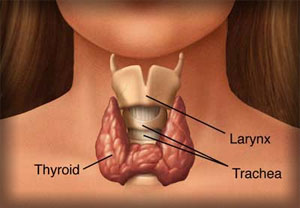Hurthle cell carcinoma is a rare type of thyroid cancer that has a bad outlook. Under the microscope, Hurthle cells look bigger than the usual follicular cells of the thyroid. There are several options of treatment for this type of thyroid malignancy, but it is important to recognize and treate it early.
What Is Hurthle Cell Carcinoma?
Hurthle cell carcinoma makes up only about 3% of all cancers affecting the thyroid gland. This neck gland is butterfly-shaped, but it is normally not visible to the naked eye. It is also responsible for producing hormones that help regulate body metabolism.
Hurthle cell cancer, also called oxyphilic cell carcinoma, is a rare condition, but is more aggressive than most types of thyroid malignancies. Surgical removal of the tumor as well as the thyroid gland is a common treatment option.
Sometimes, benign (non-cancerous) tumors involving Hurthle cells occur. These tumors can be removed surgically and do not pose a threat to life. In contrast, malignant tumors involving Hurthle cells are more serious and require early aggressive treatment.
With Hurthle Cell Carcinoma, What Symptoms Will I Have?
Symptoms of Hurthle cell carcinoma are similar to those seen in other types of thyroid cancers. These include:
- Appearance of a lump at the neck
- Voice change that does not get better
- Shortness of breath
- Sore throat
- Difficulty swallowing
- Persistent cough, not caused by a respiratory problem
Hurthle cell carcinoma complications include:
- Difficulty swallowing – when the tumor presses on the food pipe (esophagus)
- Difficulty breathing – when the tumor presses on the windpipe (trachea)
- Spread of malignancy (metastasis) to other organs and tissues
What Causes Hurthle Cell Carcinoma?
The exact cause of Hurthle cell carcinoma is not known. However, scientists believe that damaging changes or errors in the genetic material (DNA) of these cells may be involved. Damage or alteration in the DNA causes malfunction in biochemical processes that may lead to uncontrolled growth of abnormal cells, which develop into malignant tumors.
Factors that increase your risk of developing this type of thyroid cancer include:
- Being female
- Older age
- A history of radiation therapy to the head and neck
How to Diagnose Hurthle Cell Carcinoma
If you are experiencing symptoms similar to those mentioned above, consult your doctor for proper evaluation and management. Hurthle cell carcinoma is not a common condition, and your symptoms may be caused by other conditions which may or may not involve the thyroid gland.
- To diagnose a thyroid gland tumor, your doctor will ask about your health conditions in the past and conduct a thorough physical examination.
- Laboratory exams may also be requested so as to make a better diagnosis. These may include blood exams and various imaging tests such as MRI and CT scan.
- Confirmation of the diagnosis for Hurthle cell carcinoma is done after needle aspiration and biopsy of the thyroid mass. Once confirmed, your doctor will offer you various treatment options
How to Treat Hurthle Cell Carcinoma
If it is confirmed that you have Hurthle cell carcinoma, here are the best treatment you can choose to soothe your condition.
1. Surgery
This involves total or near-total thyroidectomy (removal of the thyroid). This may also include removal of surrounding lymph nodes if tumor cells have spread to them. Possible risks of thyroidectomy include nerve injury, damage to surrounding tissues like the parathyroid glands, and excessive bleeding. Removal of the thyroid necessitates lifetime hormone replacement to make up for the lost thyroid hormones.
2. Radioactive Iodine Therapy
This therapy involves intake of radioactive liquid contained in a capsule. This treatment is recommended after surgery to destroy remaining cancerous thyroid tissues. It may also be used if cancer has spread (metastasized) to other parts of the body.
Possible side effects of radioactive iodine therapy include:
- Decreased taste sensation
- Dry mouth
- Nausea
- Neck tenderness
- Sore throat
3. Radiation Therapy
This treatment involves the use of high-powered energy beams to destroy and prevent the spread of cancer cells. Possible side effects include fatigue, sore throat and skin rash.
4. Chemotherapy
This method involves the use of sorafenib (Nexavar), a drug used to treat aggressive or metastatic thyroid cancer that is not responsive to radioactive iodine therapy. Possible side effects may include diarrhea, weight loss, fatigue, high blood pressure and skin rash.
5. Other Remedies
Treatment for Hurthle cell carcinoma can be frightening and challenging. Here are some tips to help you cope with all of these things:
- Discuss your feelings with a family member or friend, or join a support group for cancer patients and families.
- Accept help from other people. Activities of daily living such as marketing or preparing meals may be taxing for cancer patients, so it is advisable to allow yourself some rest and let your loved ones help you.
- Take time to eat well, relax and rest to help combat fatigue and stress resulting from cancer.
6. Follow-Up Care
After treatments for Hurthle cell carcinoma, you will be advised to visit your doctor for regular check-up. Follow all instructions, especially with regards to the regular intake of thyroid hormone replacement after total thyroidectomy. You may also be asked to go to the hospital regularly to take blood tests to evaluate your hormone levels. Aside from these, blood tests for thyroglobulin, a cancerous tumor marker produced by Hurthle cells, may be done to monitor your condition and prevent recurring cancer.
